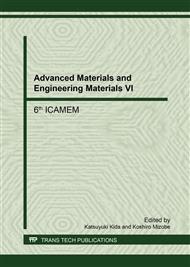p.197
p.202
p.207
p.212
p.218
p.224
p.229
p.235
p.240
Effects of Deformation and Annealing Temperature on the Microstructures and Hardness of Cu-29Zn-0.6Bi Brass
Abstract:
The use of lead-free brass is growing due to the restriction of the lead content in many components. Bismuth replaces lead in the brass alloys and contributes to the machinability and pressure tightness characteristics. However, Bi is immiscible in copper and fills the inter-dendritic spaces during solidication that yields negative impacts on the mechanical properties. This research studied the effects of addition of 0.6 wt. % Bi on the characteristics of Cu-29Zn alloy during cold rolling and subsequent annealing process. The Cu-29Zn-0.6wt.%Bi alloy was produced by gravity casting in a metal mold with the dimension of 110x110x6 mm3. The as-cast plate was homogenized at 800 °C for 2 hours and then cold rolled with the level of deformation of 20, 40 and 70 % in multiple passes. The samples with 70% deformation was annealed at 350, 400 and 450 °C for 15 minutes. Characterization of materials included Vickers hardness measurement and microstructural observation by using optical microscope and SEM. The results showed that addition of Bi reduced the grain size, formed discrete globules in the interdendritic areas and increased the hardness. The globules as dispersoid bismuth deformed and filled intergranular spaces during rolling and promoted the formation of cross slip mechanism at the 20% deformation. At the 40% deformation, the globules led to more closely spaced twin lamellae and increased the twinning density. The phenomena created an inhomogeneous deformation and promoted the formation of shear band. Annealing process dispersed the Bi globules into tight structures along the grain boundaries.The presence of dispersed bismuth increased the rate of recrystallization during annealing due to the increased in potential site for nucleation. In contrast, the dispersed bismuth acted as the pinning agent that inhibited the grain growth and developed smaller grain size which resulted in higher hardness.
Info:
Periodical:
Pages:
218-223
Citation:
Online since:
August 2017
Authors:
Keywords:
Price:
Сopyright:
© 2017 Trans Tech Publications Ltd. All Rights Reserved
Share:
Citation:


